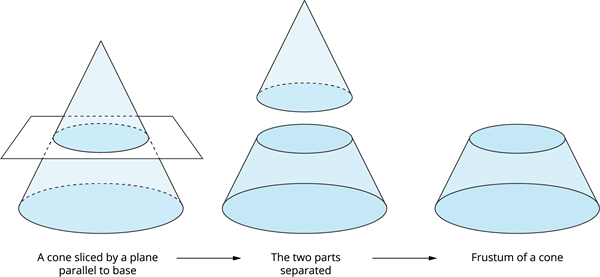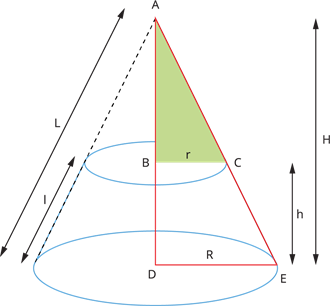UPSKILL MATH PLUS
Learn Mathematics through our AI based learning portal with the support of our Academic Experts!
Learn moreFrustum of a cone:
If a smaller end of the cone is sliced by a plane parallel to its base, the portion of a solid between this plane and the base is known as the frustum of a cone.

Volume of a frustum of a cone:

Let R and r be the radii of base (R > r), h be the height, and l be the slant height of the frustum of a cone.
We need to find the height of the smaller cone ADE.
Consider \Delta ABC and \Delta ADE.
\angle BAC = \angle DAE [common angle]
\angle ABC = \angle ADE [Both 90^\circ]
Therefore, \Delta ABC \sim \Delta ADE [by AA similarity].
The corresponding sides of similar triangles are proportional.
\frac{AB}{AD} = \frac{BC}{DE}
\frac{H - h}{H} = \frac{r}{R}
HR - hR = Hr
HR - Hr = hR
H(R - r) = hR
H = \frac{hR}{(R - r)} - - - - - - (I)
Volume of frustum = Volume of big cone - Volume of small cone
= Volume of ADE cone - Volume of ABC cone
= \frac{1}{3} \pi R^2H - \frac{1}{3} \pi r^2(H - h)
= \frac{1}{3} \pi R^2H - \frac{1}{3} \pi r^2H + \frac{1}{3} \pi r^2h
= \frac{1}{3} \pi H (R^2 - r^2) + \frac{1}{3} \pi r^2h
= \frac{1}{3} \pi \times \frac{hR}{(R - r)} (R^2 - r^2) + \frac{1}{3} \pi r^2h [using equation (I)]
= \frac{1}{3} \pi \times \frac{hR}{(R - r)} (R - r) (R + r) + \frac{1}{3} \pi r^2h
= \frac{1}{3} \pi hR(R + r) + \frac{1}{3} \pi r^2h
= \frac{1}{3} \pi h[R(R + r) + r^2]
= \frac{1}{3} \pi h[R^2 + Rr + r^2]
Volume of the frustum of a cone = \frac{1}{3} \pi h[R^2 + Rr + r^2] cu. units